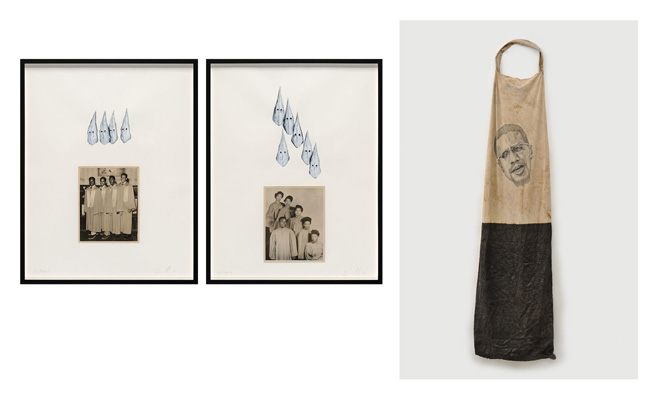Maus Contemporary
TRAVIS SOMERVILLE
The work of Travis Somerville functions as a craft of anti-nostalgia and critical memory. In his exhibition The Line , Somerville continues his sharp and creative insistence on how images and material objects are never merely inanimate relics of a past far removed from our presents or our futures, tackling the current political environment through images and exploration of the recent Confederate Monument Takedowns.
The exhibition title, The Line, refers to the line drawn in the sand in front of each and everyone of us - the line we are willing to cross, or not. The Line also refers to the lineage of our political history of white supremacy and how that has shaped today’s political landscape. Somerville compels us to reconsider and repudiate the standard measure of America’s history of white supremacy and racism as a progressive narrative that has seemingly ended on an utopian note of post-race.
The work in The Line demonstrates a scripting of American history that forgoes this progressive wish fulfillment, a rhetoric of non-culpable hope. Instead, Somerville’s work intermingles visual and verbal references to the semiotics of the Civil War, Reconstruction, Jim Crow, the Civil Rights Movement, the Age of Obama, the Age of Trump. As Somerville himself points out that his work complicates the sense of a collective memory about how race has shaped the political, historical, cultural, and social contours of America: “As I attempt to navigate the terrain between autobiography, history, and art, all sorts of collisions take place. It is these interesting moments and the inconsistencies that inform them that I try to capture in my work.”
Through the re-staging of old advertisements and newspapers, vintage money bags and cotton sacks, and the poignant juxtaposition of his drawing and painting against found photos, Somerville brilliantly entices the viewer to marvel over the aesthetic power of American culture’s everyday brutality and myopia.
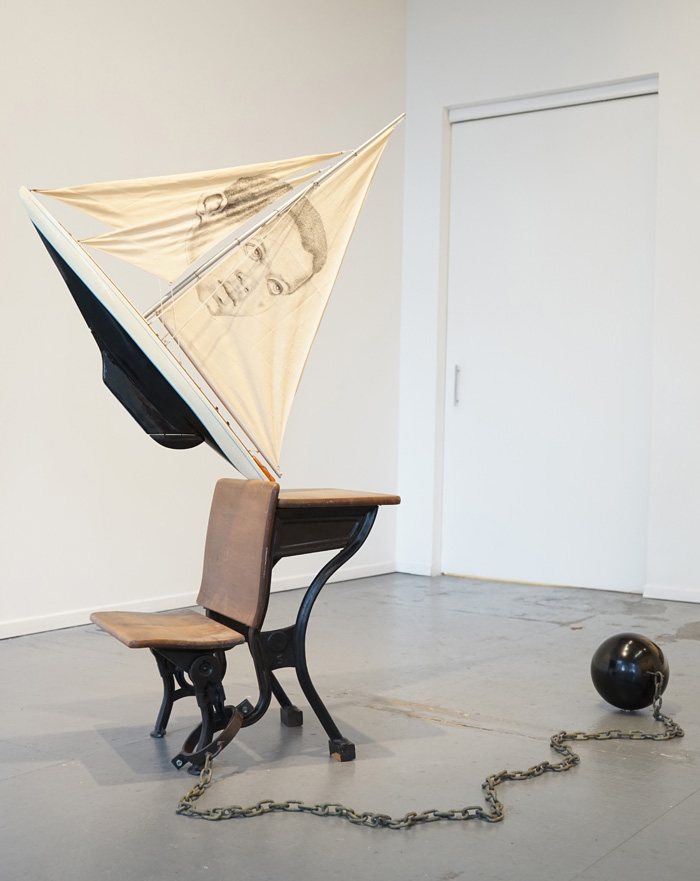 Travis Somerville "Board of Education", 2018
Travis Somerville "Board of Education", 2018
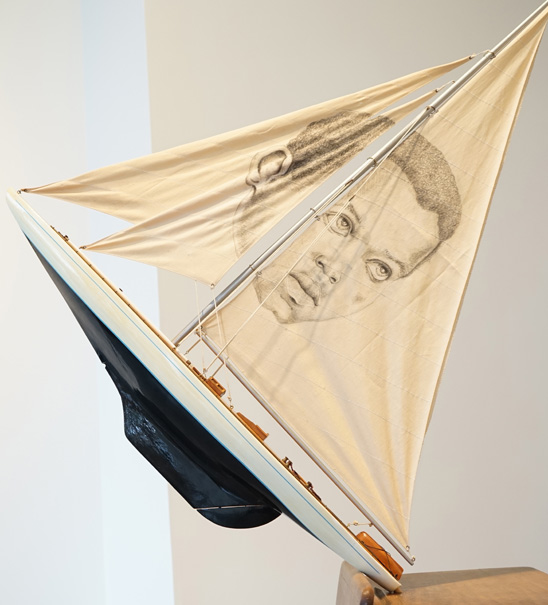 Travis Somerville "Board of Education" (detail), 2018
Travis Somerville "Board of Education" (detail), 2018
Travis Somerville Board of Education
2018, graphite on sail cloth, model boat, vintage children's school desk,
metal neck shackle, metal chain, bowling ball
as installed approx. 63 by 72 by 38 in.
(ca. 160 by 182,9 by 96,5 cm)
private US collection
 Historical Takedown, 2018
Historical Takedown, 2018
Travis Somerville Historical Takedown
2018, acrylic, oil, and collage on unstretched canvas
approx. 81.5 by 98 in. (ca. 207 by 248,9 cm)
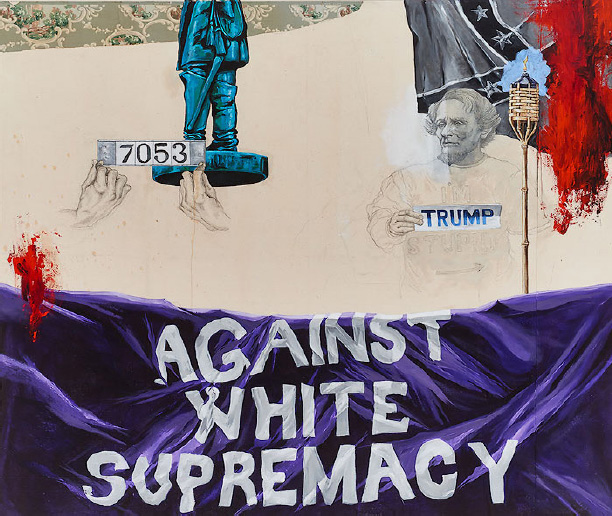 Afternoon in The Park, 2018
Afternoon in The Park, 2018
Travis Somerville Afternoon In The Park
2018, acrylic, graphite, and collage on unstretched canvas
approx. 75 by 79 in. (ca. 190,5 by 200,7 cm)
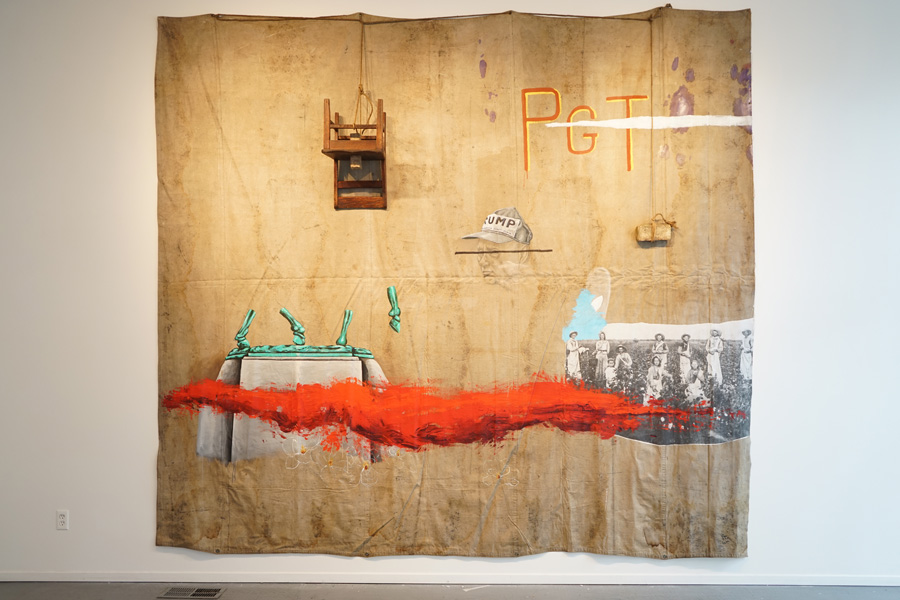 The Line, 2018
The Line, 2018
Travis Somerville The Line
2018, acrylic, collage, rope, chair, and brick on found, unstretched canvas tarp
approx. 118 by 124 in. (ca. 299,7 by 315 cm)
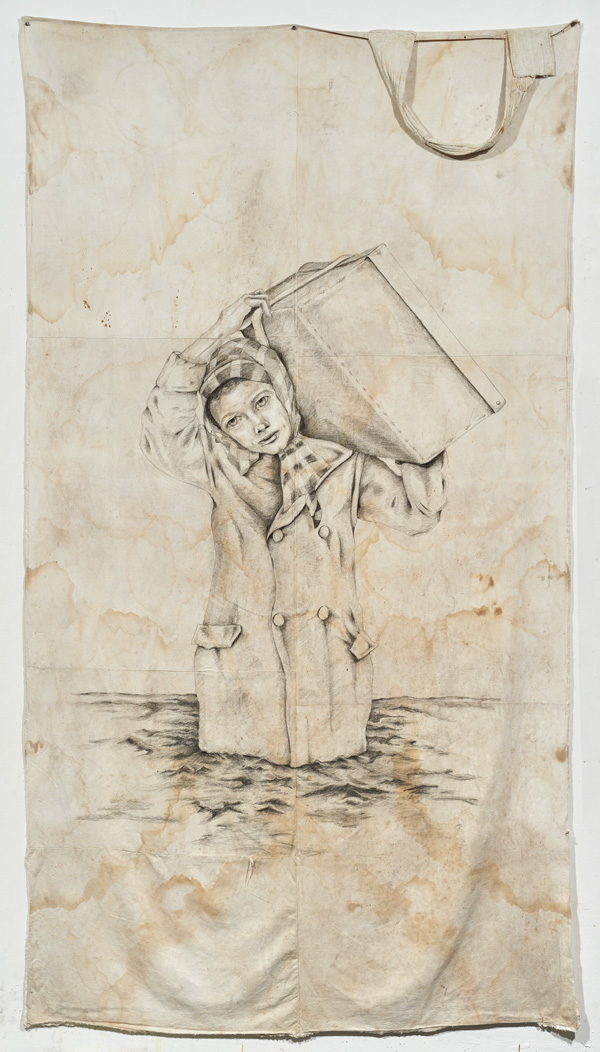
Travis Somerville This Land
2017, graphite on vintage cotton picking sack
approx. 101 by 52.5 in. (ca. 256,5 by 133,3 cm)
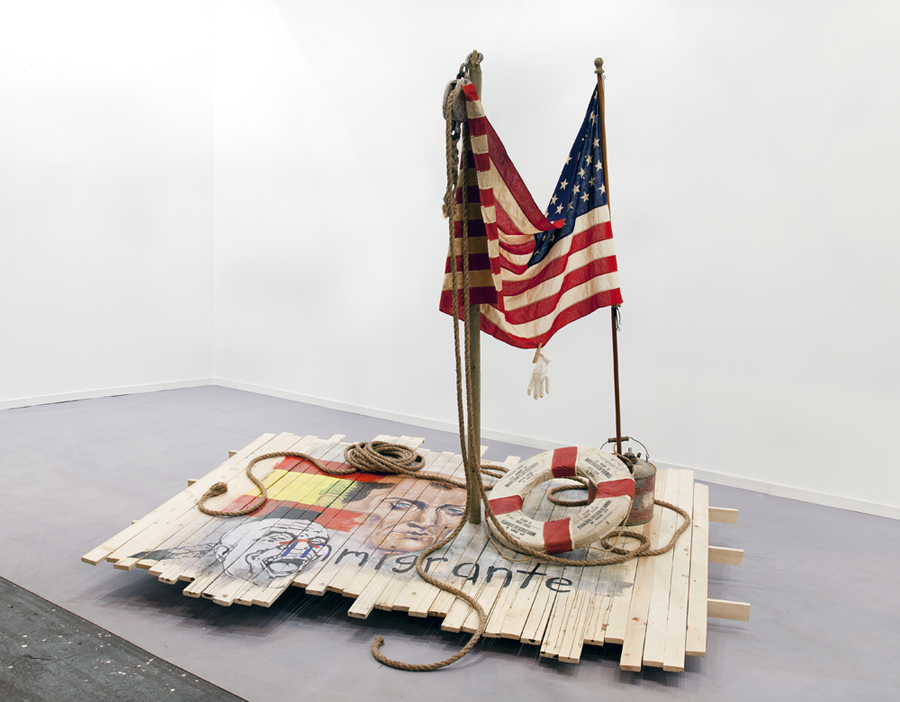
Travis Somerville War Paint
2016, oil on wood, rope, pulley, gas can, flag,
cotton glove, flag fragments, and money bags
approx. 80 by 97 by 75 in. (ca. 203 by 246 by 190 cm)
collection of CAC Málaga
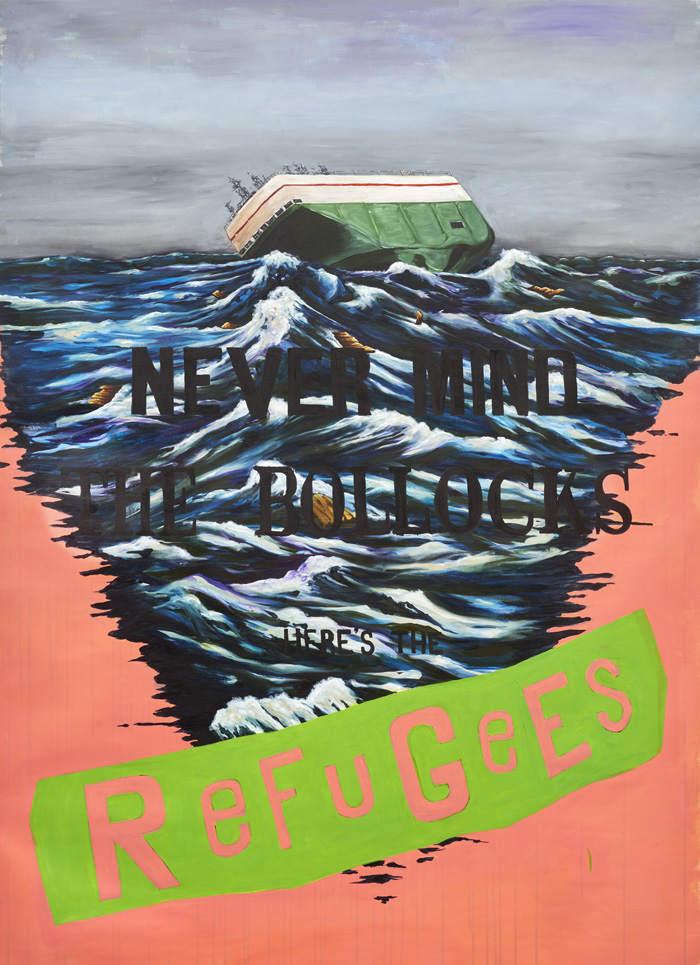
Travis Somerville Nevermind
2016, oil on unstretched canvas
approx. 72 by 50.75 in. (ca. 183 by 129 cm)
private collection San Francisco
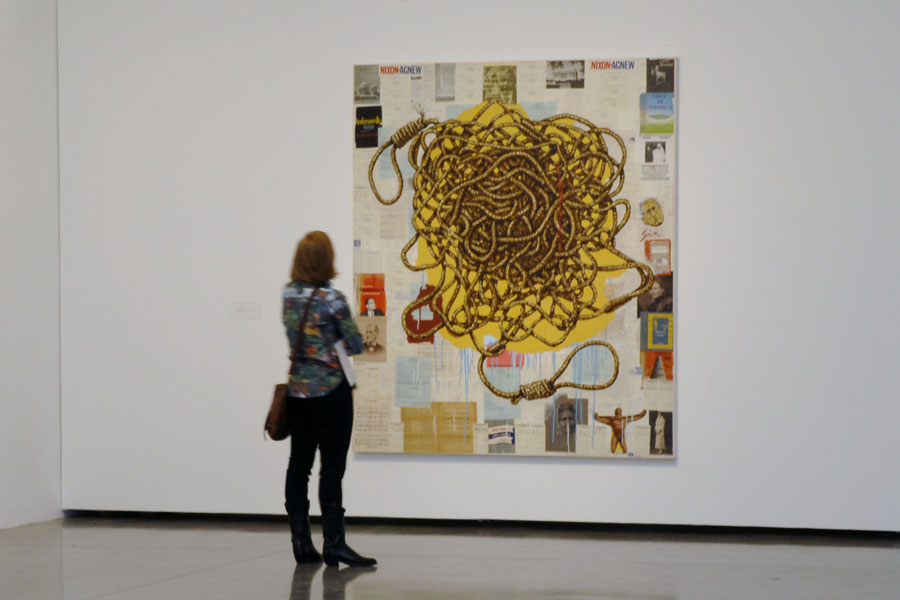 "Double No" shown at the Otis College of Art and Design's Ben Maltz Gallery in 2009
"Double No" shown at the Otis College of Art and Design's Ben Maltz Gallery in 2009
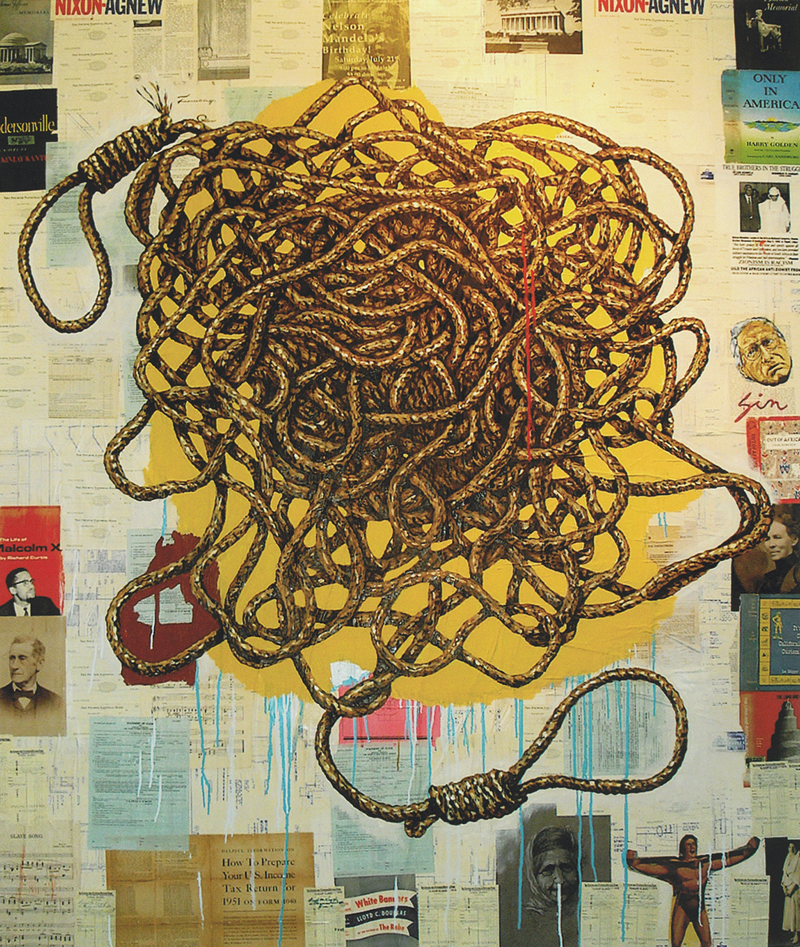
Travis Somerville
Double Not
2008
oil and collage on canvas
84 by 72 in.
private US collection
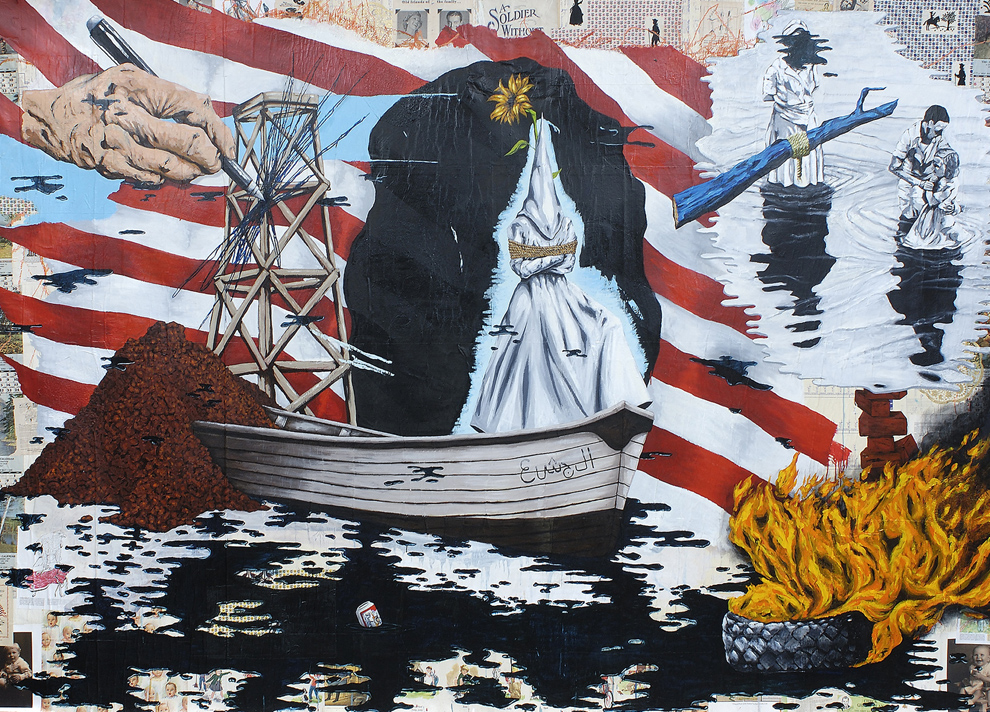
Travis Somerville Great Expeditions
2009, oil and mixed media on unstretched canvas
94 by 140 in. (ca. 238 by 355 cm)
Great Expeditions is a painting caught between hope and despair. The American flag bisects the painting from the left while a disembodied hand holding a pen is poking through the fabric and scribbling out a large oil derrick as if trying to come up with the next idea. Floating on a sea of bubbling crude, while simultaneously being run aground in a pile of dirt, is a rowboat christened Greed in Arabic, transporting a Klansman with a large sunflower sprouting from the top of his white hood. The vigilante symbol of bigotry, hate, and ignorance is being restrained and used to fertilize and generate a new and positive ideal of growth and prosperity. Somerville references the German painter Anselm Kiefer by using a sunflower as a symbol of hope and good things to come. In the upper right corner, a baptism is taking place under as floating blue tree limb with the rope - remains of a severed noose. Is it a spiritual, emotional, or ethnic cleansing we are witnessing? Below is a burning tire, a technique employed to create a smoke screen, to protect us from our enemies while also blinding us from the reality of our environmental demise. Along the border are collaged images from a 1948 Sportsman calendar.
_______
The work of Travis Somerville functions as a craft of anti-nostalgia and critical memory. This webpage showcases a selection of Somerville’s new work that continues his sharp and creative insistence on how images and material objects are never merely inanimate relics of a past far removed from our presents or our futures.
Somerville compels us to reconsider and repudiate the standard measure of America’s history of white supremacy and racism as a progressive narrative that has seemingly ended on an utopian note of post-race. The artist's work demonstrates a scripting of American history that forgoes this progressive wish fulfillment, a rhetoric of non-culpable hope. Instead, Somerville’s work intermingles visual and verbal references to the semiotics of the Civil War, Reconstruction, Jim Crow, the Civil Rights Movement, and the Age of Obama. As Somerville himself points out that his work complicates the sense of a collective memory about how race has shaped the political, historical, cultural, and social contours of America: “As I attempt to navigate the terrain between autobiography, history, and art, all sorts of collisions take place. It is these interesting moments and the inconsistencies that inform them that I try to capture in my work.” Through the restaging of old advertisements and newspapers, vintage money bags and cotton sacks, and the poignant juxtaposition of his drawing and painting against found photos, Somerville brilliantly entices the viewer to marvel over the aesthetic power of American culture’s everyday brutality and myopia. What more could one want from art?
______
The tumultuous history of race relations in the South has been, in large part, buried and left to fester in the years since the Civil War. While culture is intangible and abstract, its artifacts are available as evidence of its existence. Born in Atlanta, Georgia and raised throughout the South, Travis Somerville unapologetically picks at these old wounds by exposing the popular objects and iconography of Southern culture. Somerville’s use of imagery is complex and shaped significantly by his personal relationship to it. His critical eye works in the shadow of his own nostalgia and consequently attempts to reconcile the idealism of his religious upbringing with the racial and political turmoil of his past.
Somerville’s irreverent installations, paintings and embellished photographs incorporate suggestive symbols of the South’s troubled history such as Ku Klux Klan hoods and Confederate flags as well as doo-rags, whiskey bottles and images of popular advertising from the more recent past, explore the complexities of racism and serve as a platform for discussion about US oppression and colonial attitudes abroad. His graphite-on-paper portraits take their subjects from vintage photographs and offer a more reflective side of his historical excavation. The suggestive content, although sensitive, attempts to unearth the complexities and contradictions in post-antebellum society rather than condemn it. Somerville has recently expanded on these ideas by exploring how the contemporary concerns of the South - most salient in the aftermath of Hurricane Katrina - stand as a metaphor for exported racism and colonialism.
Somerville’s work has been included in numerous museum exhibitions including at the University of Georgia, de Saisset Museum at Santa Clara University, Florida A&M University, Laguna Art Museum in Laguna Beach, California, the Smithsonian Institution in Washington, D.C., and Los Angeles County Museum of Art, among many others. His show Places I’ve Never Been was on exhibit at the San Francisco Arts Commission in 2012, and his work was included in Newtopia: The State of Human Rights, an international exhibition of 70 contemporary artists dedicated to Human Rights; the exhibition was held at various prominent cultural institutions in Mechelen, Belgium and was curated by Katerina Gregos.
Somerville's solo exhibition Rebirth of a Nation: Travis Someville's 1963 at the Crocker Art Museum, curated by Diana L. Daniels, featured the mixed-media installation 1963, a three-dimensional construction which measures 7' high and 12' wide. 1963 is the study of a volatile and pivotal year in American history through sculpture, video, painting, and collage.
Travis Somerville has gathered critical attention in numerous publications including The Washington Post, Art in America, FlashArt and The Los Angeles Times.
His work is included in numerous Museum collections, including SFMoMA; the 21c Museum in Louisville, KY; the 21c Museum in Bentonville, AK; the Museum of Contemporary Art San Diego, San Jose, CA; the Birmingham Museum of Art in Birmingham, Alabama; the Walker Art Center in Minneapolis, Minnesota; and the CAC Málaga Museum, Málaga, Spain.
Lilly Lampe's SCULPTURE MAGAZINE review of Travis Somerville's exhibition American Rhetoric at beta pictoris gallery / Maus Contemporary
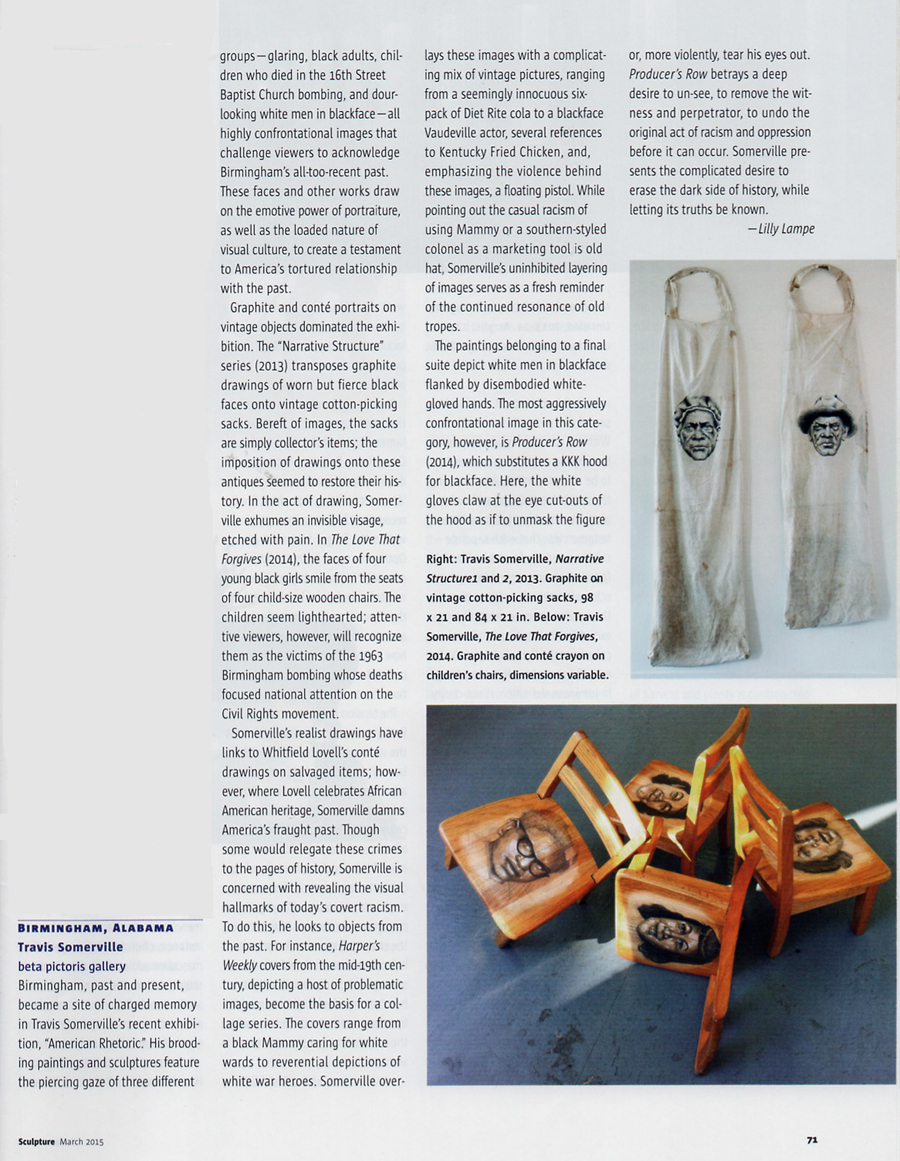
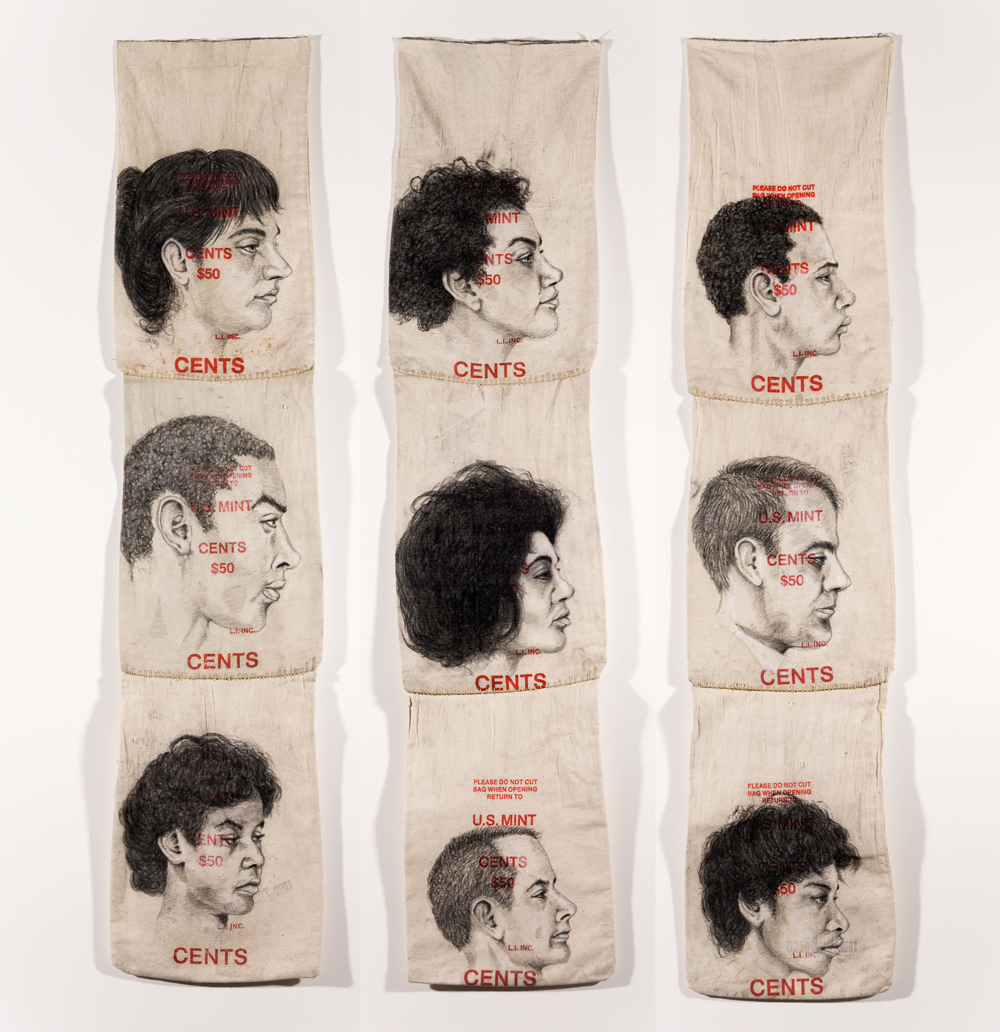
Travis Somerville Freedom Mugs
2015, graphite on vintage money bags, three sections
ca. 122 by 26 cm per section (ca. 48 by 10 in. per section)
installed ca. 121 by 91 cm (ca. 48 by 36 in.)
The portraits on Freedom Mugs are based on the mugshots of Freedom Riders arrested 1961 in Jackson, Mississippi.
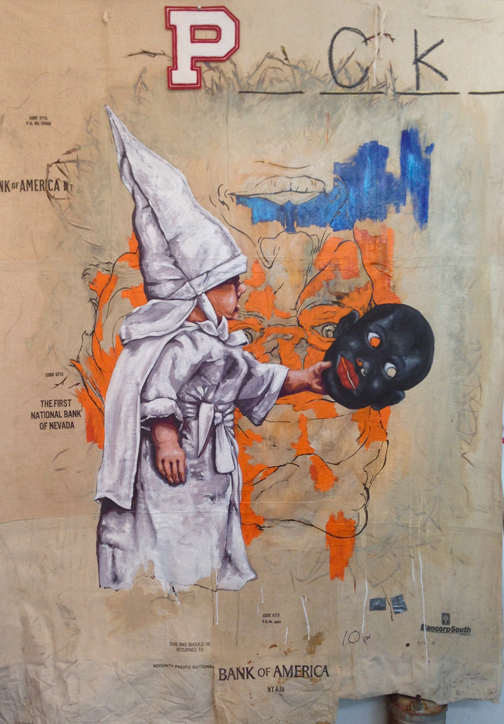
Travis Somerville Dress Up Daze
2014, oil, school letter, and thread on vintage money bags,
mounted on unstretched canvas
ca. 213 by 147 cm (84 by 58 in.)
private collection Belgium
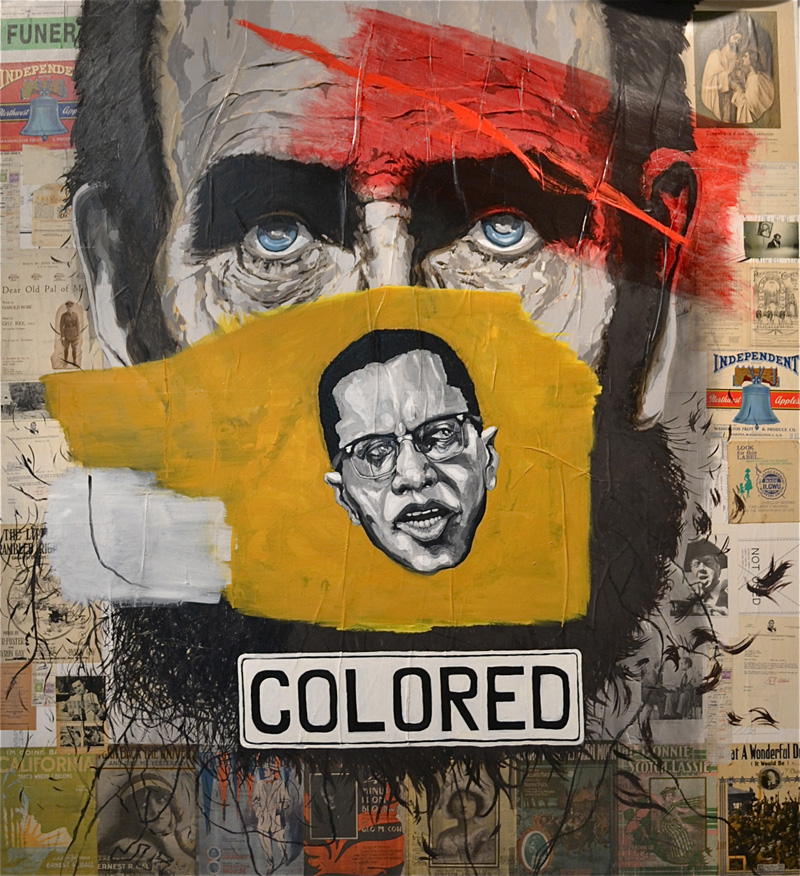
Travis Somerville
Old Pal of Mine
2012
oil and collage on canvas
88 by 81 in.
private collection Switzerland
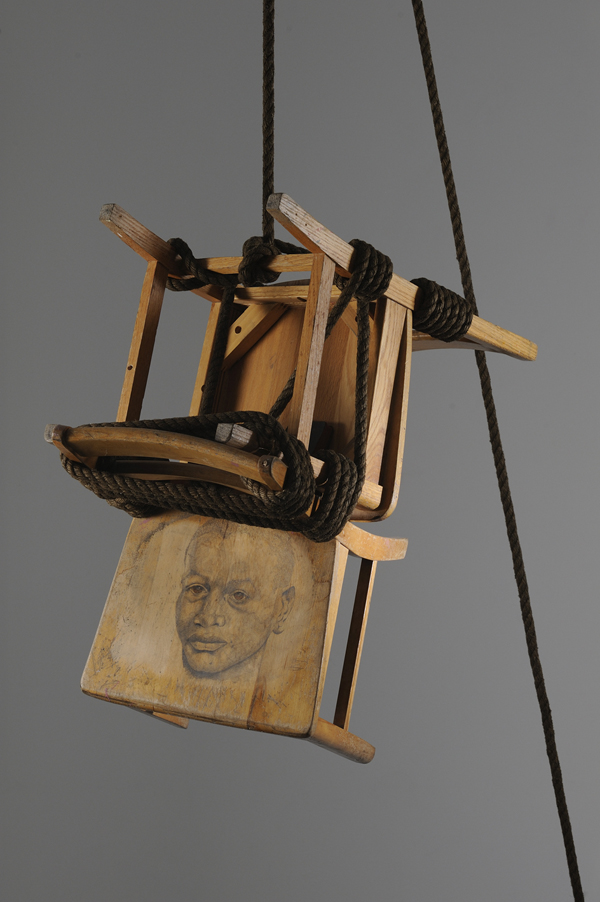
Travis Somerville Ballad for George Stinney
2013, graphite on vintage wooden Children Chair, rope, bible, metal pully, weight
dims variable
collection of the 21c Museum, Louisville, KY
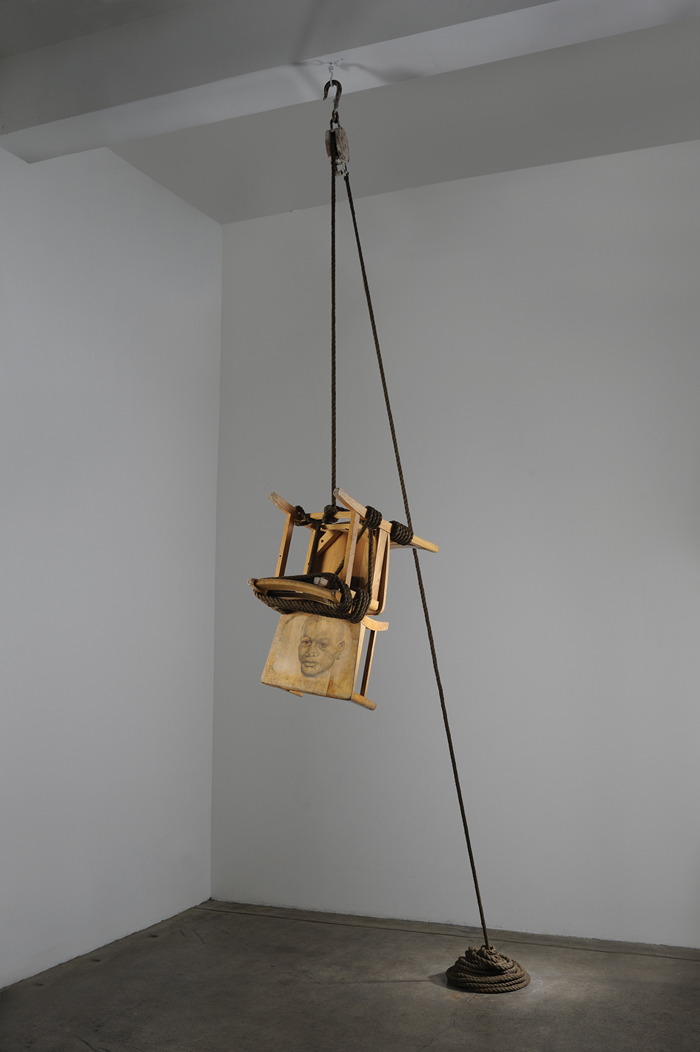
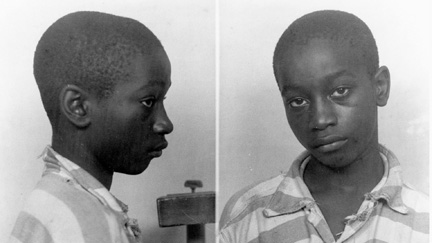 George Junius Stinney, Jr. (October 21, 1929 – June 16, 1944) was, at age 14, the youngest person executed in the US in the 20th century.
George Junius Stinney, Jr. (October 21, 1929 – June 16, 1944) was, at age 14, the youngest person executed in the US in the 20th century.
Convicted in a two-hour trial of the murder of two young white girls. However, no physical evidence existed in the case, and the sole evidence against Stinney was the circumstantial fact that the girls had spoken with Stinney and his sister shortly before their murder, and the testimony of three police officers that Stinney had confessed. He was executed by electric chair on June 16, 1944.
Stinney walked to the execution chamber with a bible under his arm. As the boy was only 5 feet 1 inch (155 cm) tall and weighing just over 90 pounds (40 kg), his size (relative to adult prisoners) presented difficulties in securing him to the frame holding the electrodes. His bible was then used as a booster seat in the electric chair.
Since Stinney's conviction and execution, the question of his guilt, the validity of his confession, and the judicial process leading to his execution have been criticized as "suspicious at best and a miscarriage of justice at worst.'
On December 17, 2014, 70 years after his execution, Stinney's conviction was vacated by circuit judge Carmen Mullen, who cited that as the youth had not received any kind of defense at his trial, therefor violating his Sixth Amendment rights. The ruling was a rare use of the legal principle of coram nobis (a legal writ issued by a court to correct a previous error "of the most fundamental character" to "achieve justice" where "no other remedy" is available). Judge Mullen ruled that his confession was likely coerced and thus inadmissible.
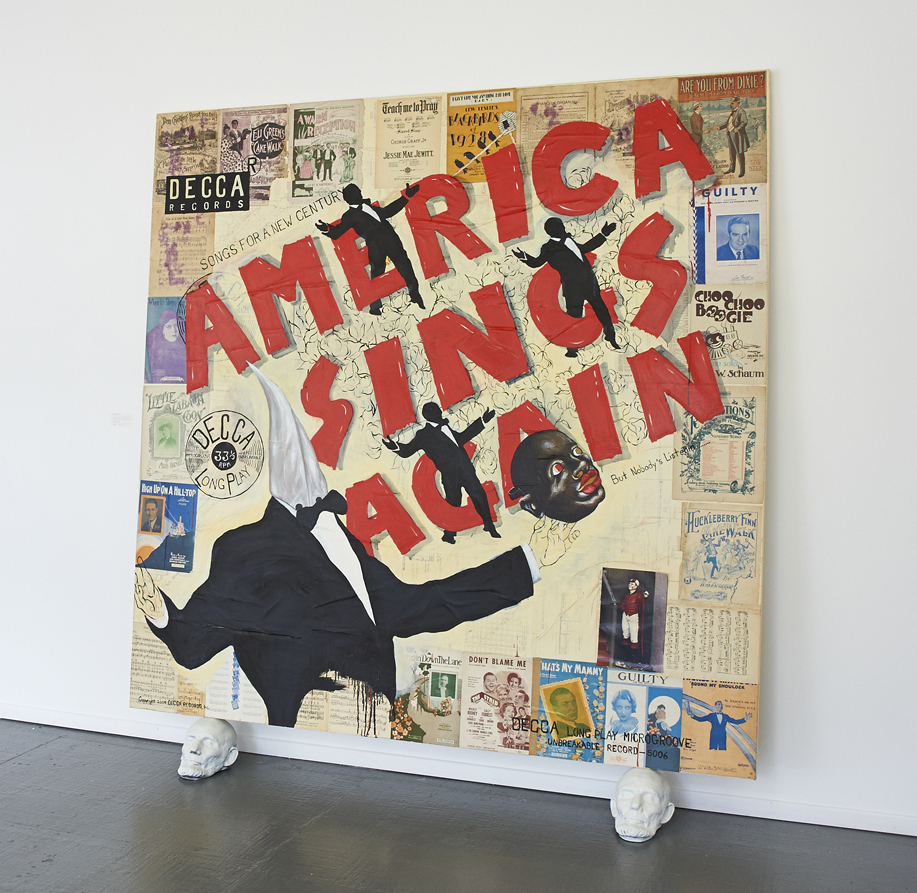
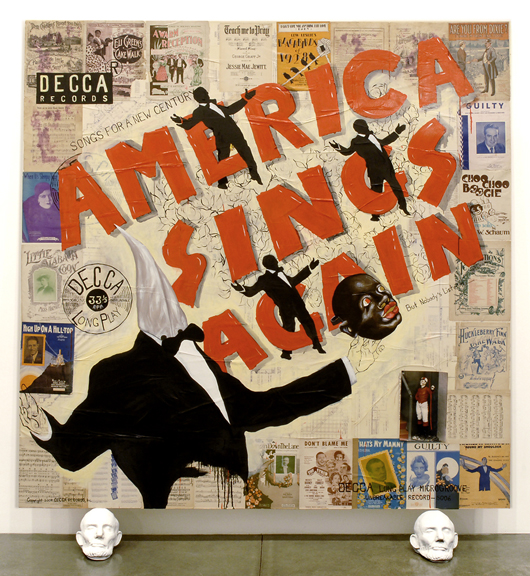
Sing Out America
2009
oil and collage on canvas, plaster casts
ca. 91 by 84 by 16 ½ inches
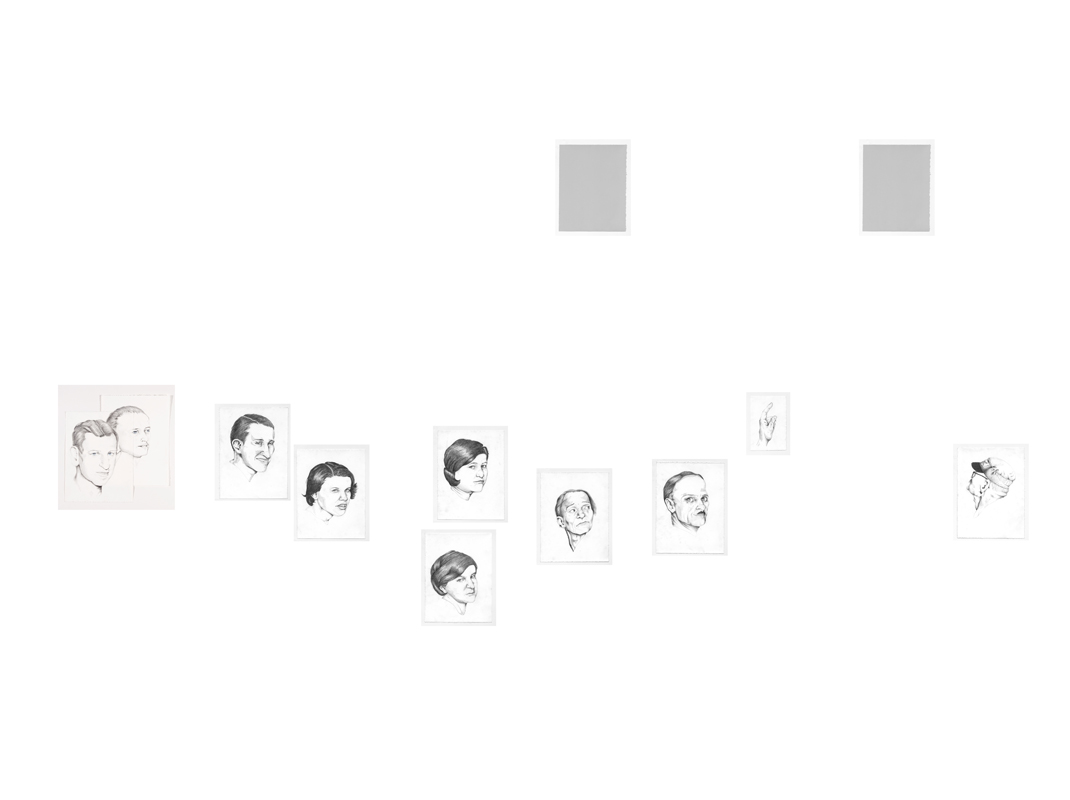
Travis Somerville Crowd Source
2015, graphite on paper, eleven individually framed elements
dims variable, as installed ca. 80 by 126 in. (ca. 203 by 320 cm)
collection of the 21c Museum, Louisville, KY
This work is based on the famous photograph taken by Lawrence Beitler of the lynching of Thomas Shipp and Abram Smith in Marion, Indiana on August 7, 1930.
A Lynching in the Heartland: Marion, Indiana, August 7, 1930
by James H. Madison
On a hot August night in 1930 a crowd gathered in front of an Indiana jail—men, women, and children shouting and jeering, demanding that the sheriff release his three prisoners. Three African American teenagers—Tom Shipp, Abe Smith, and James Cameron—huddled inside their cells, charged with the murder of a white man and the rape of white woman. Some among the thousands of people in front of the jail formed a mob. They beat down the jail doors, pulled the three youths from their cells, brutally beat them, and dragged them to a tree on the courthouse square. At the last minute the mob spared Cameron, the youngest and most boyish of the trio. Smith and Shipp died, lynch ropes around their necks, their bodies hanging as the town photographer captured one of the most famous lynching photographs in American history.
This Marion, Indiana, lynching is among several thousand in American history, though unlike most it happened in the North and in a community with little harsh racial antagonism. It also happened “late,” decades after the heyday of late nineteenth-century vigilante violence. Yet the Marion tragedy, like many southern lynchings, was a spectacle lynching. The mob was not content to murder their victims at the jail or to carry them off to an isolated spot. They chose the courthouse square because it was the civic and geographical center of town. The mob deliberately performed their drama on that stage, using lynch ropes as their central props. They insisted the county coroner not immediately cut down the two bodies. They must hang through the night, they shouted, to send a message to blacks who stepped out of line. Long after the sheriff finally cut the lynch ropes, the photograph remained: the upper half with its vivid brutality; the lower half showing ordinary Americans without sorrow or shame.
Some in Marion and elsewhere challenged this extralegal violence. Flossie Bailey, the head of the local chapter of the National Association for the Advancement of Colored People (NAACP), immediately sent demands for justice to local and state authorities and called personally on the governor. She also contacted Walter White, the head of the national NAACP. White travelled to Marion from his New York office to conduct his own investigation. He identified mob leaders and issued his report. The NAACP’s magazine, the Crisis, ran the brutal photograph as part of the organization’s long campaign against lynching. So did some African American newspapers. Many whites expressed regret but failed to act. The exception was the Indiana attorney general, James Ogden, who initiated his own investigation. Most local authorities resisted, and all claimed they could not identify mob leaders.
Outside pressures for justice, particularly from Ogden and White, eventually caused the trial of two accused mob leaders, but each was quickly found innocent by juries of twelve white men. No one was ever punished for the murder of Tom Shipp and Abe Smith. A small victory came when Flossie Bailey successfully pressured the Indiana state legislature to pass a stricter antilynching law in 1931. Bailey and others also used the Indiana tragedy to argue for federal legislation, supported even by the Marion newspaper, but that movement failed.
The photograph and the memories remained. As late as the civil rights struggles of the 1950s some whites in Marion reminded African Americans of what would happened if they violated white norms. Increasingly, however, the memories turned to shame, sometimes suppressed in a willful forgetting, sometimes pulled out to encourage the necessity of justice for all.
No one forgot, certainly not black Americans. Sarah Weaver Pate, a teenager in 1930, told an interviewer in 1994 that “we’re like the rabbit now; we don’t trust the sound of a stick.”(1) James Cameron, the sixteen year-old who survived the lynching, never forgot. He titled his autobiography Time of Terror (2). He devoted the last decades of his life to telling the story, always in contexts of justice and American ideals. More Americans came to understand that lynching was not a sidebar but a central feature of American history.
James H. Madison is the Thomas and Kathryn Miller Professor of History at Indiana University. Among his publications is A Lynching in the Heartland: Race and Memory in America (2001), which focuses on a 1930 lynching in Marion, Indiana. Click on above photograph by Lawrence Beitler to order James H. Madison's book on Amazon.
(1) James H. Madison, A Lynching in the Heartland: Race and Memory in America (New York, 2001), 143.
(2) James Cameron, A Time of Terror (Milwaukee, 1980).
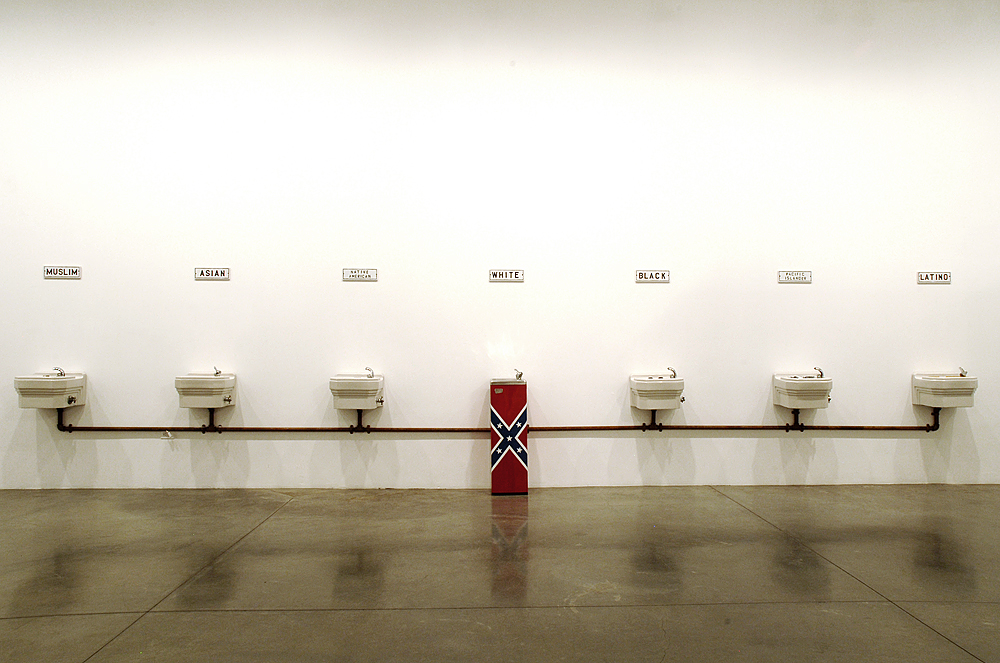
Well Division
2009
acrylic on vintage porcelain drinking fountains and panels, auto paint on metal drinking fountain,
copper pipes and running water
ca. 80 by 318 by 14 in.

Well Division (detail)
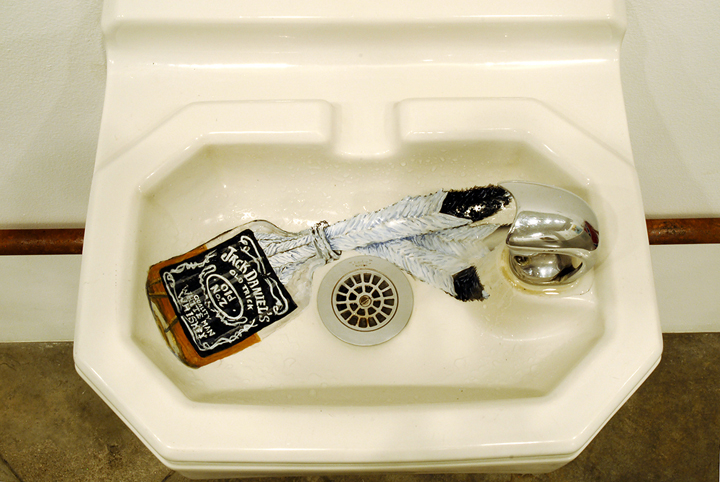
Well Division (detail)
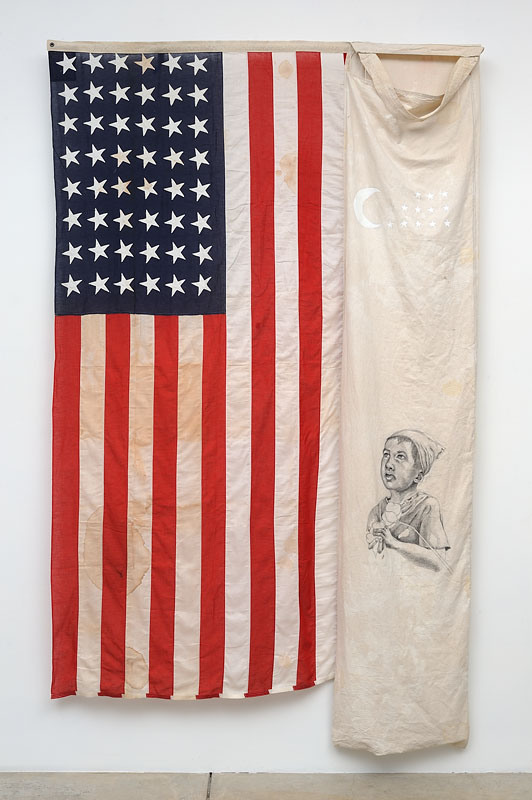
Travis Somerville Hamma Pahtada
2013, pencil and gesso on vintage cotton picking sack with flag
ca. 310 by 188 cm (122 by 74 in.)
private collection, São João da Madeira, Portugal
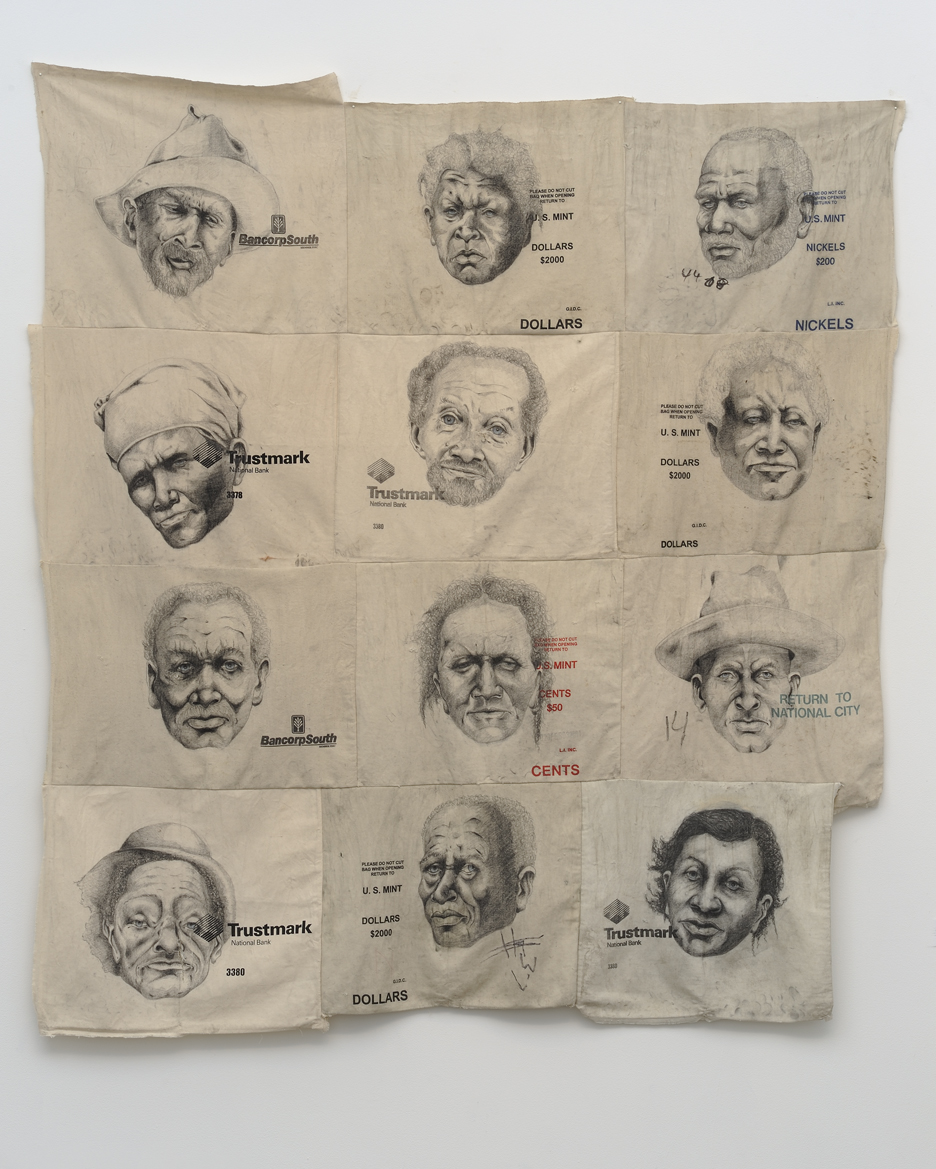
Born Into It
2012
graphite on vintage money bags
72 by 64 in.
private collection, Copenhague, Denmark
The portraits on Born Into It are sourced through the Library of Congress from a series of portraits taken during the WPA period to document people who had been born during/into slavery.
Their portraits on vintage money bags, bearing inscriptions such as “return to...”, “Trustmark” or “BancorpSouth”, are powerful hints to slave narrative and slave history,
and the use of money bags refers to these humans as a commodity.
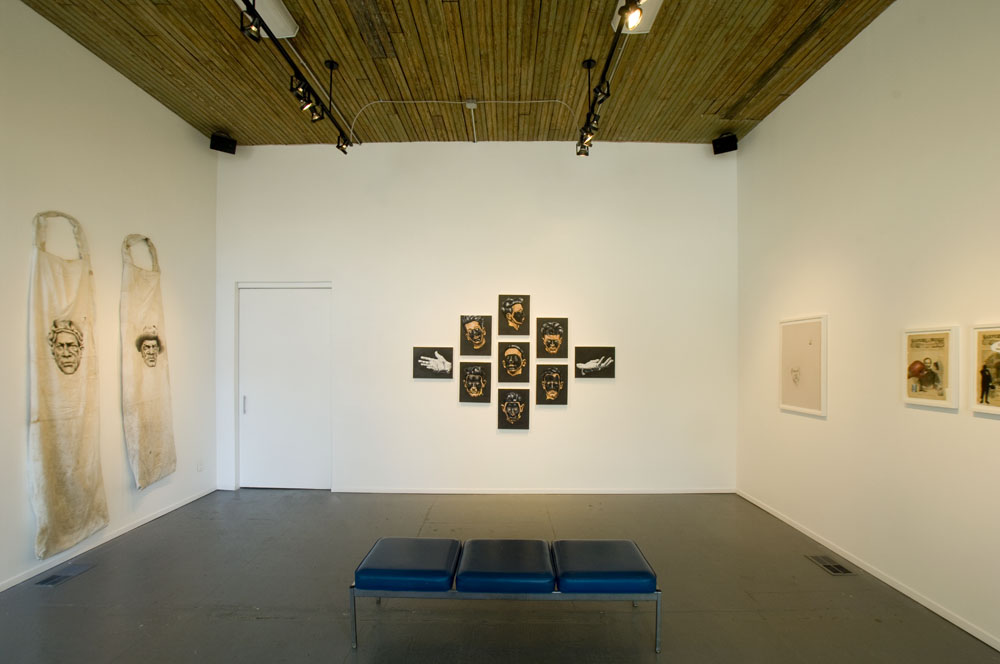
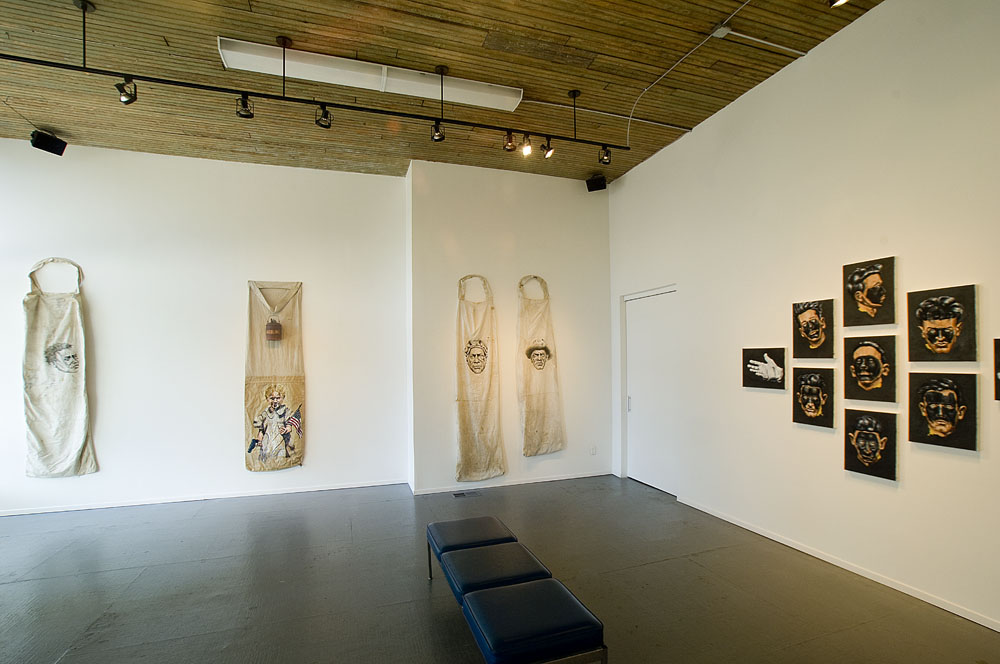

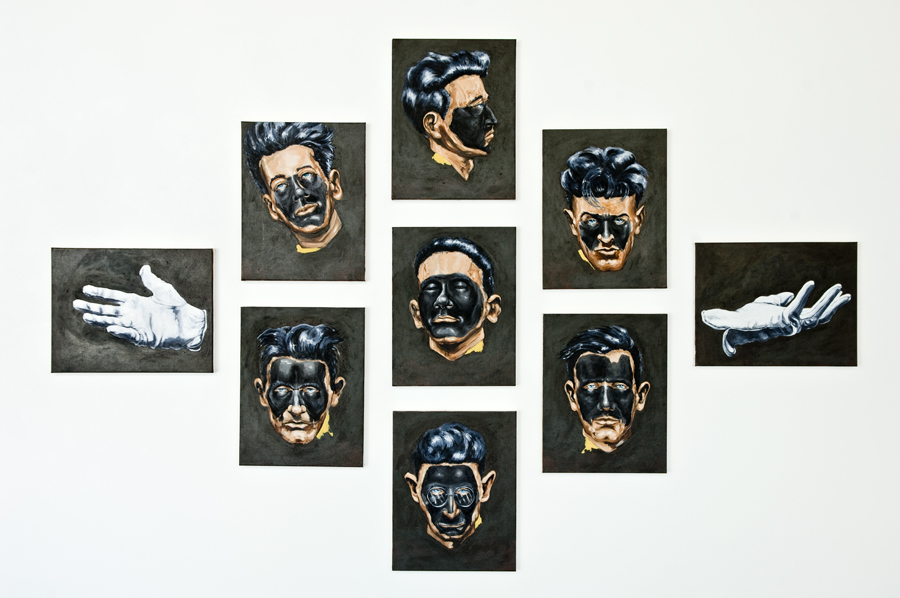
The Big Show
2014
oil on canvas
dims variable (as installed 60 by 90 in.)
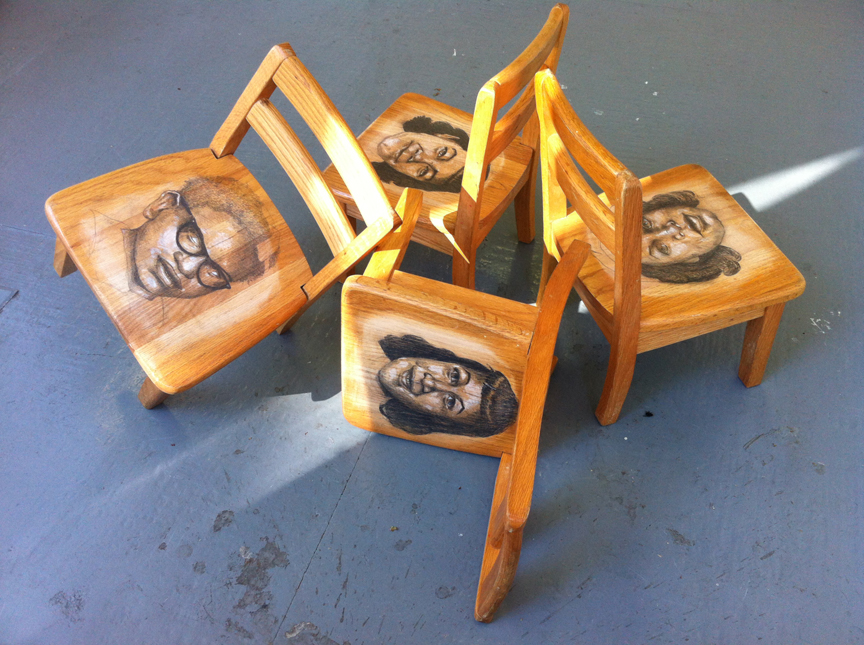
The Love That Forgives
2014
graphite and conté crayon on Children Chairs
dims variable (as installed ca. 40 by 36 by 20 in. high)
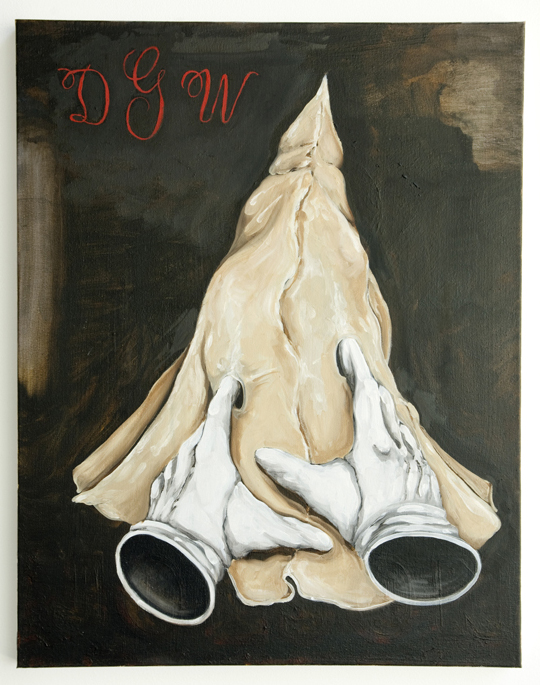
Producers Row
2014
oil on canvas
28 by 22 in.

Little Boy Blue
2014
oil and graphite on vintage cotton picking sack, metal gasoline can,
US flag fragment, cotton glove
ca. 60 by 26 by 9 in.
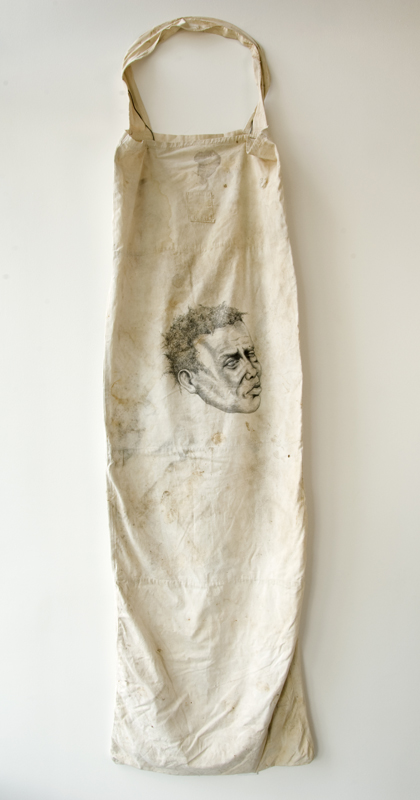
Narrative Structure 3
2013
graphite on vintage cotton picking sack
96 by 21 in.
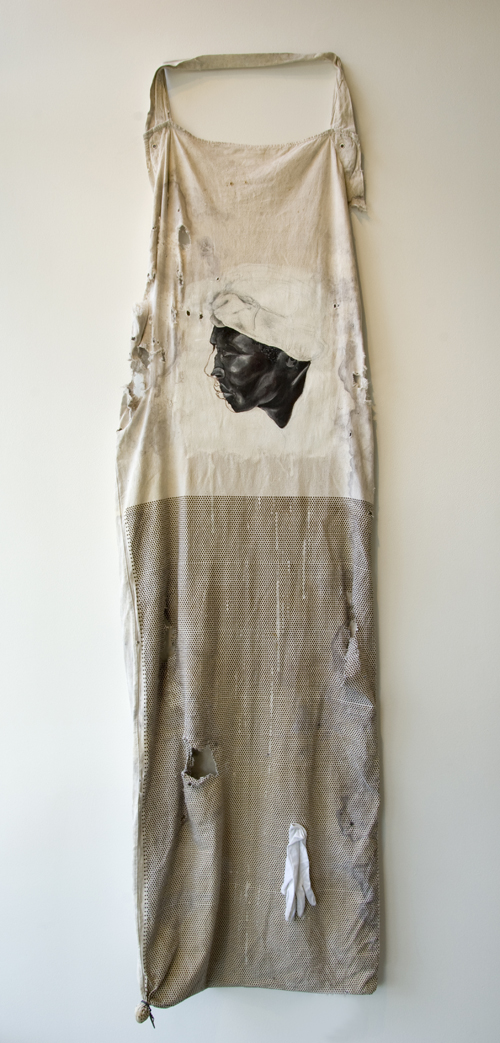
Pickin Season
2014
oil, pencil, and acrylic on vintage cotton picking sack, white cotton glove
ca. 80 by 26 in.
private collection New York, NY
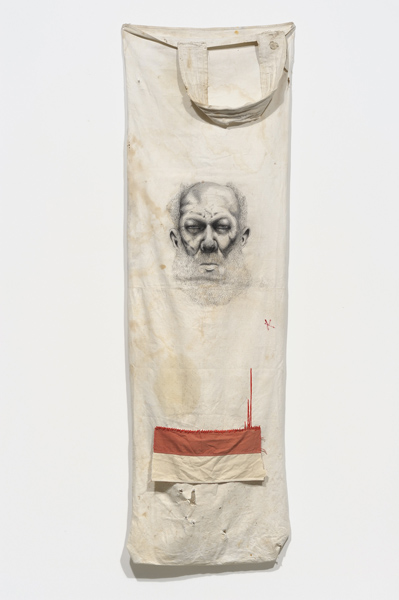
American Dream III
2014
graphite, US flag fragment, and yarn on vintage cotton picking sack
ca. 83 by 26 in.
private collection Miami, FL
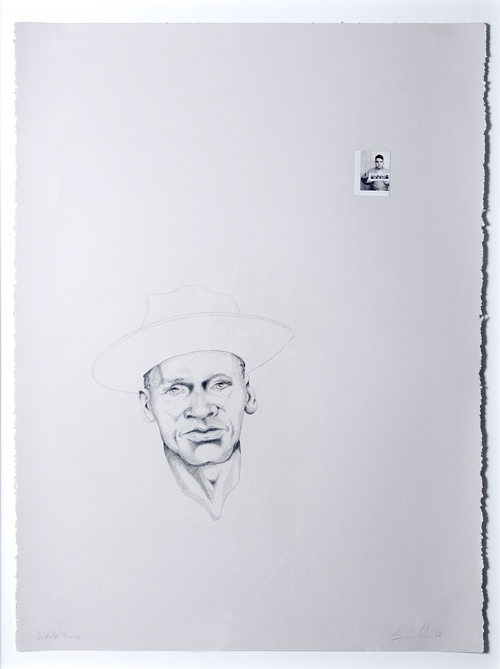
White Crimes
2013
graphite and vintage photo on paper
ca. 30 by 22.5 in.
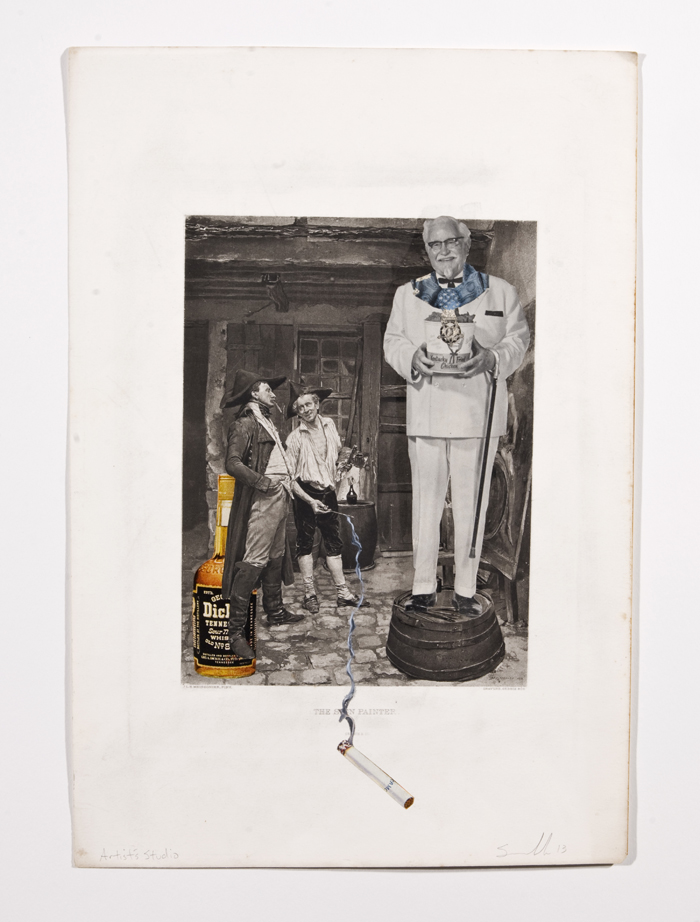
Artist's Studio
2013
acrylic and collage on vintage ephemera
ca. 16.75 by 11.5 in.
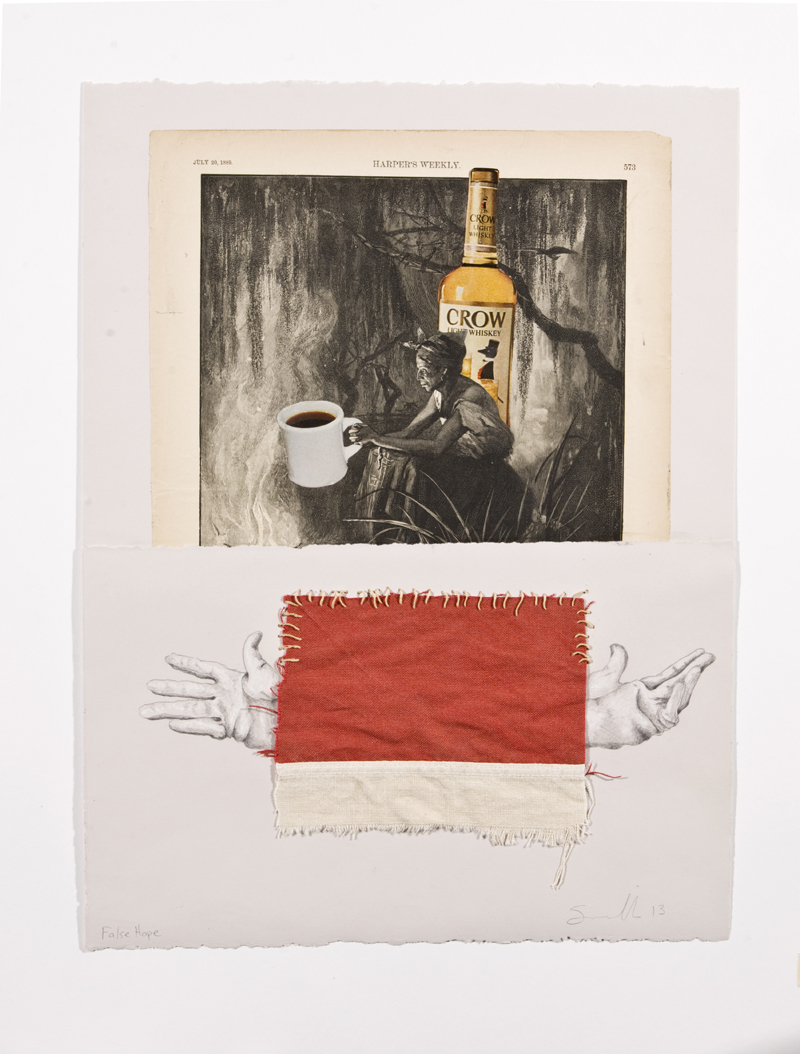
False Hope
2013
US flag fragment, yarn, pencil, conté crayon, and collage on vintage ephemera
ca. 18.5 by 13.75 in.
l to r: Choir Robe 1, Choir Robe 2, Ain’t No Uncle Tom, all 2013
